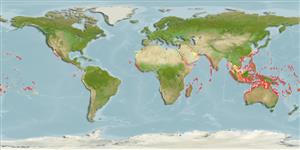Common names from other countries
Environment: milieu / climate zone / depth range / distribution range
Sinh thái học
Biển Cùng sống ở rạn san hô; Mức độ sâu 0 - 50 m (Ref. 7348). Tropical; 30°N - 30°S
Indo-Pacific: East Africa eastward through northern Australia to Hawaiian, Marquesas and Tuamotu islands, north to southern Japan.
Length at first maturity / Bộ gần gũi / Khối lượng (Trọng lượng) / Age
Maturity: Lm 14.0 range ? - ? cm
Max length : 30.0 cm TL con đực/không giới tính; (Ref. 4420); common length : 15.0 cm TL con đực/không giới tính; (Ref. 5450)
Các tia vây lưng cứng (tổng cộng) : 3; Các vây lưng mềm (tổng cộng) : 23 - 26; Tia cứng vây hậu môn: 0; Tia mềm vây hậu môn: 21 - 23.
Commonly found in subtidal reef flats and shallow protected lagoons, Ref. 48637. Benthopelagic (Ref. 58302). Juveniles secretive with rubble patches, adults swim about openly but are usually shy (Ref. 48637). Territorial. Feed on algae, detritus, mollusks, crustaceans, worms, sea urchins, fishes, corals, tunicates, forams, and eggs (Ref. 3921). Oviparous (Ref. 205). Sleep on its side; makes a whirring noise when alarmed (Ref. 4420). Also caught with drive-in nets and is considered a popular aquarium fish (Ref. 9770).
Life cycle and mating behavior
Maturities | Sự tái sinh sản | Spawnings | Egg(s) | Fecundities | Ấu trùng
Distinct pairing (Ref. 205). Mating system may be a mixture of polygyny, monogamy, and potential promiscuity in solitary females but the primary mating system considered for this species is polygyny (Ref. 116439). Females are territorial, solely tending and guarding the eggs (Ref. 116451). Males exhibit polygyny (Ref. 116451).
Myers, R.F., 1991. Micronesian reef fishes. Second Ed. Coral Graphics, Barrigada, Guam. 298 p. (Ref. 1602)
IUCN Red List Status (Ref. 130435)
CITES (Ref. 128078)
Not Evaluated
Threat to humans
Reports of ciguatera poisoning (Ref. 130160)
Human uses
Các nghề cá: buôn bán nhỏ; Bể nuôi cá: Tính thương mại
Các công cụ
Special reports
Download XML
Các nguồn internet
Estimates based on models
Preferred temperature (Ref.
115969): 24.5 - 29, mean 27.7 (based on 1010 cells).
Phylogenetic diversity index (Ref.
82804): PD
50 = 0.5078 [Uniqueness, from 0.5 = low to 2.0 = high].
Bayesian length-weight: a=0.01905 (0.01109 - 0.03275), b=2.93 (2.78 - 3.08), in cm Total Length, based on LWR estimates for this species & (Sub)family-body (Ref.
93245).
Mức dinh dưỡng (Ref.
69278): 3.2 ±0.1 se; based on diet studies.
Thích nghi nhanh (Ref.
120179): Chiêù cao, thời gian nhân đôi của chủng quần tối thiểu là dưới 15 tháng (K=0.4).
Fishing Vulnerability (Ref.
59153): Low to moderate vulnerability (30 of 100).
